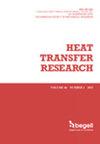增强和优化可持续供热应用中三种流体热交换器的热液压特性
IF 1.6
4区 工程技术
Q3 THERMODYNAMICS
引用次数: 0
摘要
本研究对带有三种流体的热交换器(HEFT)的热液压性能和能效进行了实验研究。三流体热交换器由两根直管和一根螺旋管组成,螺旋管插入最外层和最内层之间,以实现更好的热传递。本热交换器用于用另一种流体 TF1(热水)同时加热两种流体(TF2:普通水和 TF3:空气)。在试验过程中,TF1 的流量保持在三个水平(即 100、200 和 300 LPH),TF2 的流量保持在三个水平(即 50、100 和 150 LPH),TF3 的流速保持在三个水平(即 1、2 和 3 m/s),TF1 的入口温度保持在两个水平(即 60 和 80 摄氏度)。采用田口-格雷关系耦合分析法确定控制参数的最佳组合,以预测优化的总体性能。结果表明,TF1 的入口温度被预测为对 JF 因子、放能效率和可持续性指数最具决定性的因素,其贡献率分别为 41.29%、63.06% 和 60.66%。在 TF1 的入口温度为 60℃、TF1 的流量为 100 LPH、TF2 的流量为 150 LPH 和 TF3 的流速为 3 m/s 的条件下,预测了 HEFT 的优化性能,并证实其灰色关系等级显著提高了 32.9%。本文章由计算机程序翻译,如有差异,请以英文原文为准。
Enhancement and optimization of thermo-hydraulic characteristics of a heat exchanger with three fluids used in sustainable heating applications
Experimental investigation of the thermo-hydraulic and exergetic performance of a heat exchanger with three fluids (HEFT) was carried out in the present work. The HEFT comprises of two straight tubes and a helical tube inserted in between the outermost and the innermost tube for better heat transfer. The present heat exchanger is projected for heating of two fluids (TF2: normal water and TF3: air) simultaneously by another fluid TF1 (hot water). During the examination, three levels of TF1 flow rate (i.e., 100, 200, and 300 LPH), three levels of TF2 flow rate (i.e.,50, 100, and 150 LPH), three levels of TF3 flow velocity (i.e., 1, 2, and 3 m/s, and two levels of TF1inlet temperature (i.e., 60, and 80 degrees Celsius) are maintained. A coupled Taguchi-Grey relational analysis is employed to determine the optimum combination of control parameters to forecast optimized overall performances. The outcomes show that, the inlet temperature of TF1 is forecasted as the most decisive factor for the JF factor, exergy efficiency, and sustainability index with a contribution of 41.29%, 63.06%, and 60.66% respectively. The optimized performance of the HEFT is forecasted at 60℃ inlet temperature of TF1, 100 LPH flow rate of TF1, 150 LPH flow rate of TF2, and 3 m/s velocity of TF3 and confirmed with significant enhancement in Grey relational grade of 32.9%.
求助全文
通过发布文献求助,成功后即可免费获取论文全文。
去求助
来源期刊

Heat Transfer Research
工程技术-热力学
CiteScore
3.10
自引率
23.50%
发文量
102
审稿时长
13.2 months
期刊介绍:
Heat Transfer Research (ISSN1064-2285) presents archived theoretical, applied, and experimental papers selected globally. Selected papers from technical conference proceedings and academic laboratory reports are also published. Papers are selected and reviewed by a group of expert associate editors, guided by a distinguished advisory board, and represent the best of current work in the field. Heat Transfer Research is published under an exclusive license to Begell House, Inc., in full compliance with the International Copyright Convention. Subjects covered in Heat Transfer Research encompass the entire field of heat transfer and relevant areas of fluid dynamics, including conduction, convection and radiation, phase change phenomena including boiling and solidification, heat exchanger design and testing, heat transfer in nuclear reactors, mass transfer, geothermal heat recovery, multi-scale heat transfer, heat and mass transfer in alternative energy systems, and thermophysical properties of materials.
 求助内容:
求助内容: 应助结果提醒方式:
应助结果提醒方式:


